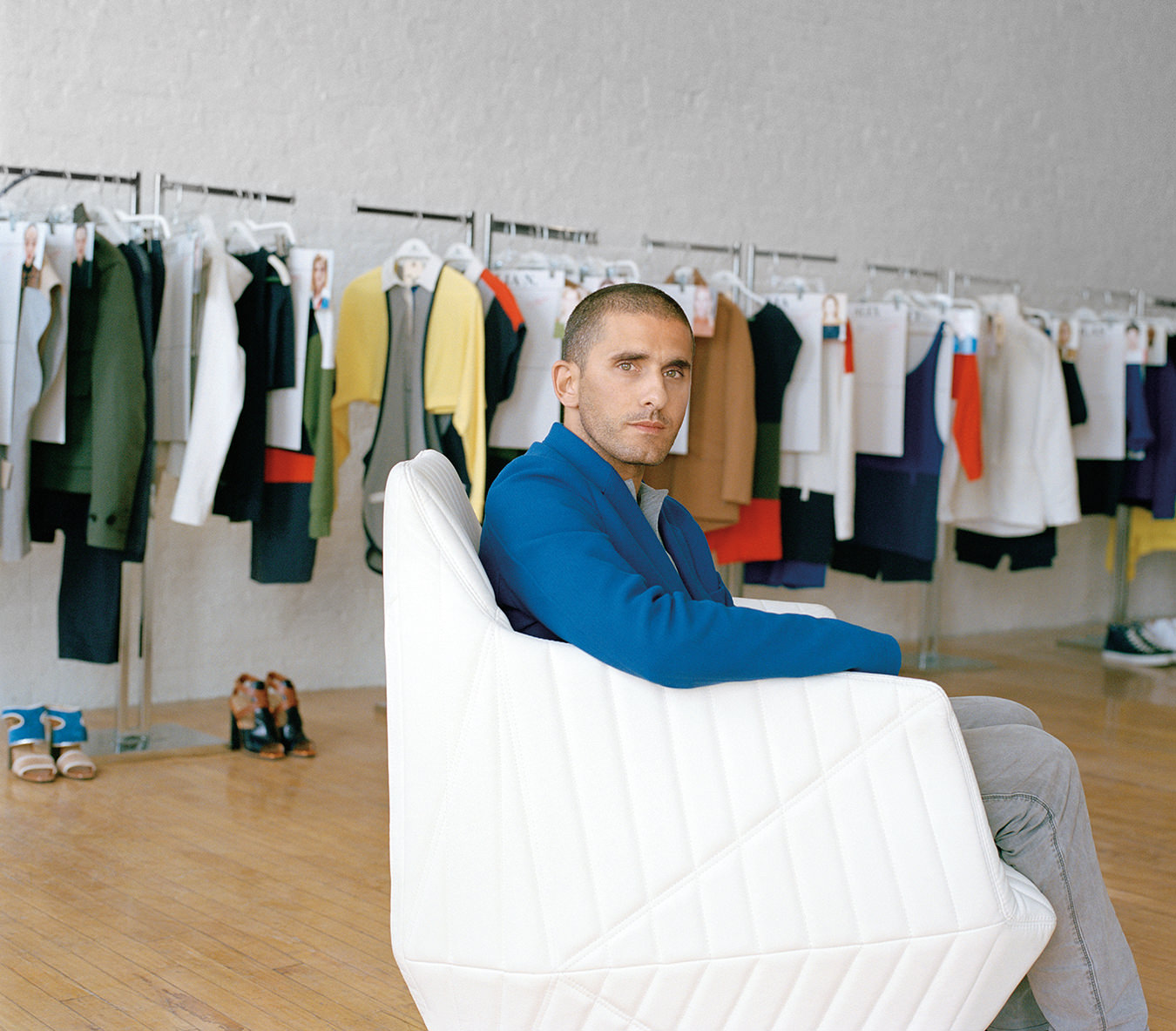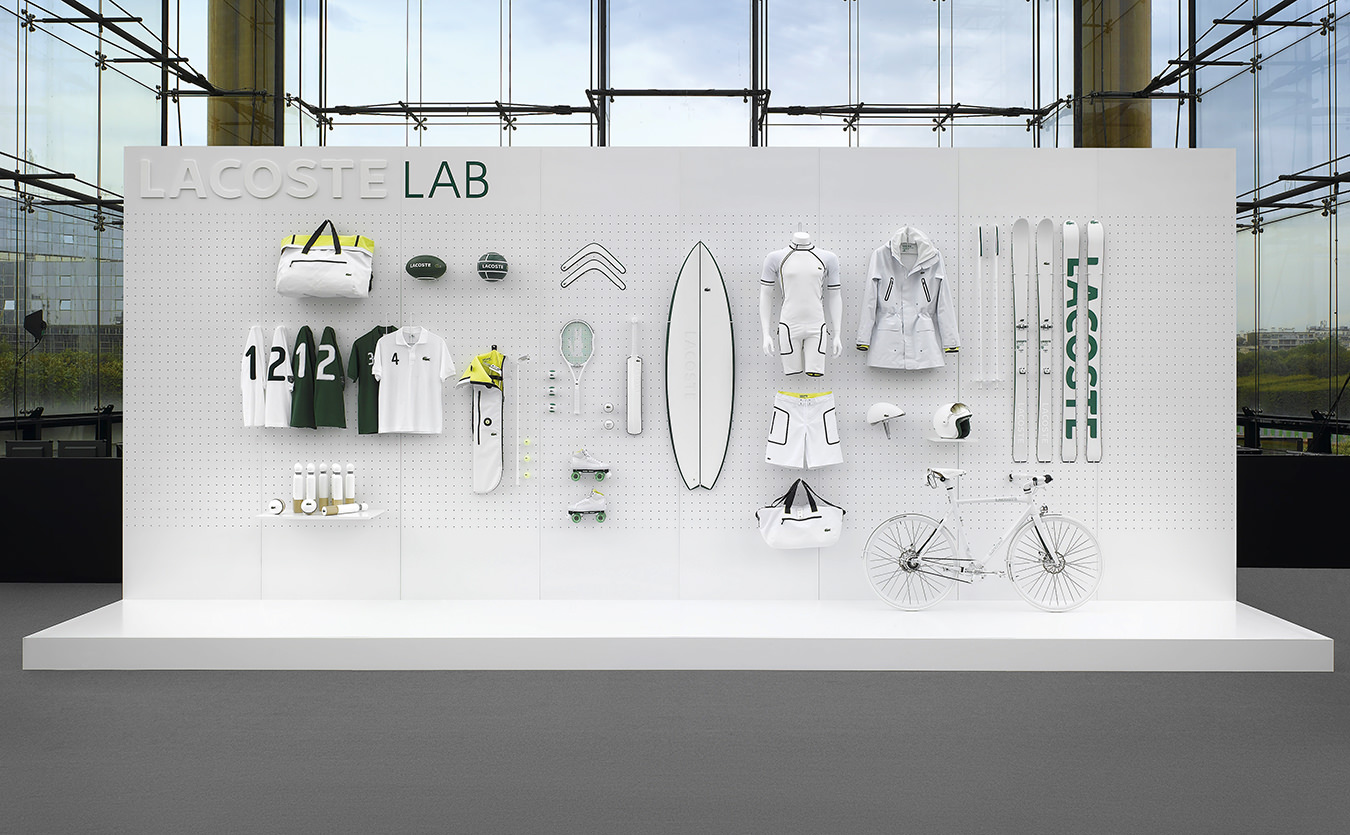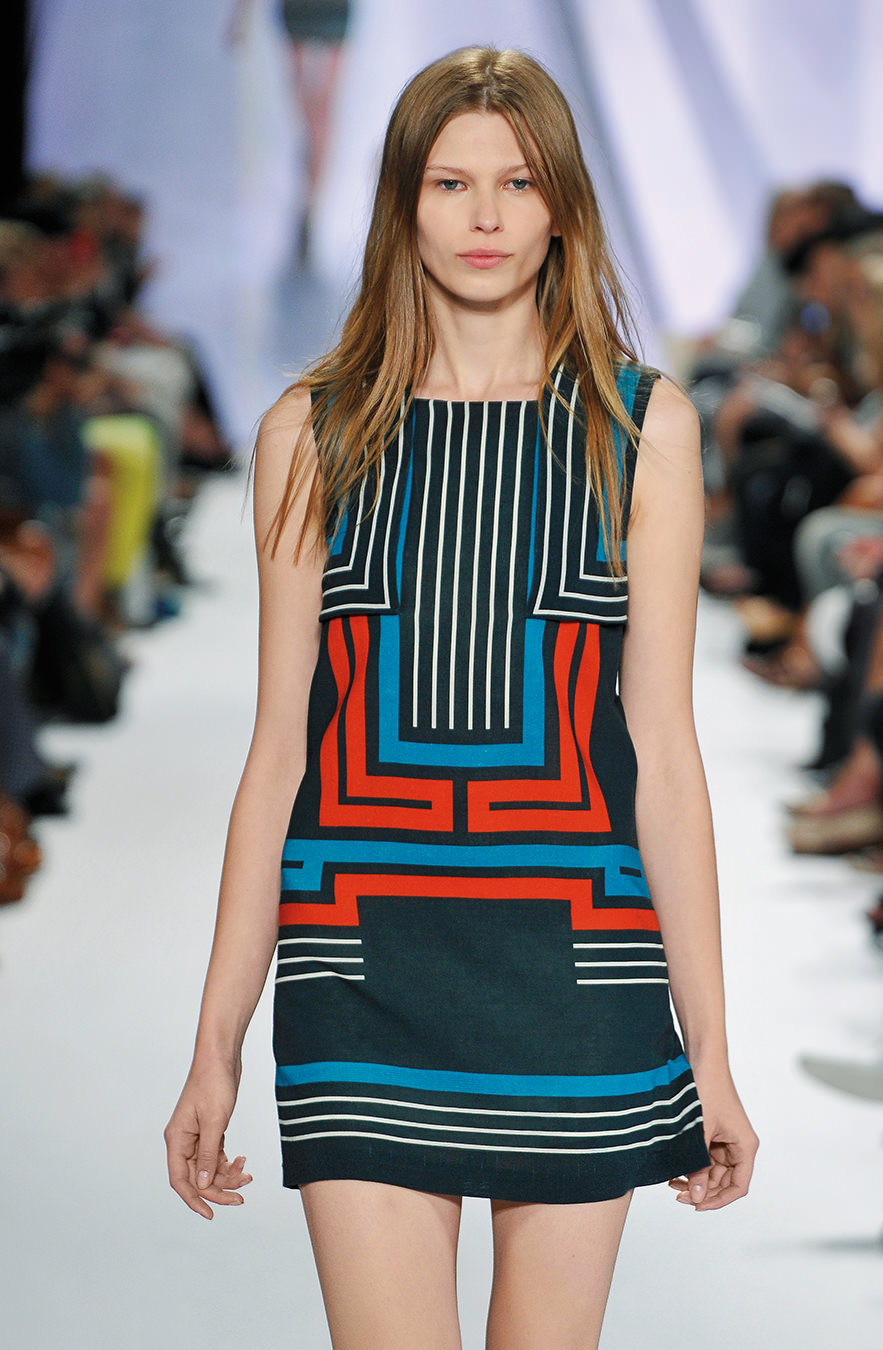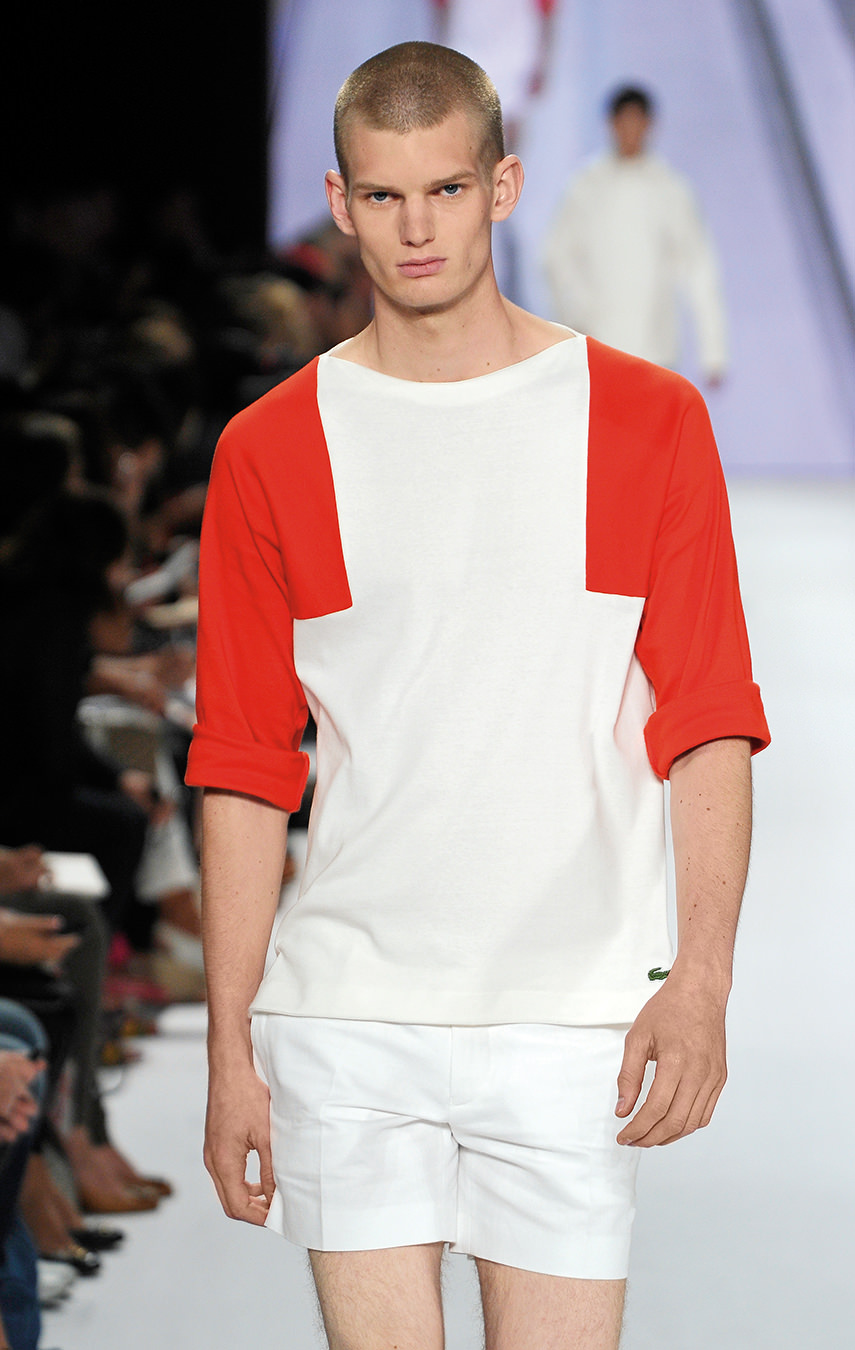-

-

The Lacoste Lab wall display.
-

The Lacoste spring/summer 2012 collection.
-

The Lacoste spring/summer 2012 collection.
Felipe Oliveira Baptista
Lacoste du Jour.

“I’m feeling a bit tipsy,” says Felipe Oliveira Baptista, the heralded new guy at Lacoste. This tipsy feeling is not from downing too many celebratory toasts. (At least, not yet—it’s only 2:45 p.m.) Baptista has just debuted his first collection as creative director for the storied label, and he’s high on pure adrenaline. “I’m happy the way it went down,” he says of the spring/summer 2012 show at Lincoln Center during New York Fashion Week last September. “It will take a few days to get proper feedback but I think it’s assured that we won.”
Baptista’s words may reek of confidence but he is, admittedly, nervous. And perhaps his nerves are warranted, as he’s only a few months into his new gig. Baptista has taken the reins as lead designer from Christophe Lemaire (who moved on to Hermès) and plans to “reinterpret the French sportswear chic,” he says. What began as a one-product brand defined by a crocodile nearly 80 years ago has evolved into a lifestyle.
Baptista is no newcomer to the fashion scene and hardly a surprising choice for Lacoste. The Portuguese designer treads between easy-to-wear, multi-referential pieces for his own label, and a high-fashion twist for his capsule collections with Uniqlo and Nike. After graduating from Kingston University London in 1997, Baptista went on to design for Max Mara, Christophe Lemaire, and Cerruti before founding his own label in 2003. Now, he’s ready to infuse his playful, androgynous lines into the sportswear label. (He will continue with his namesake line as well.) “I really want to make the brand more real and urban,” he says of his vision for Lacoste. “My idea is to create stories around colour, create novelty, and use colour in a more subtle way.”
Lacoste was built on a notion of sport. This sport, at first, included only the game of tennis. René Lacoste was a French tennis player who garnered victories at French Opens in 1925, 1927, and 1929; at Wimbledon in 1925 and 1928; and the U.S. Open in 1926 and 1927. It was a bet that he made with Allan H. Muhr, the captain of the French Davis Cup team that spawned a famous reptile and a branding sensation. In admiring a crocodile-skin suitcase and agreeing to a bet to receive it in exchange for winning an important match in 1927, René acquired (along with the suitcase, which he won) the nickname “the Crocodile”. The American press gave him the name and René cherished it, requesting a crocodile be embroidered on his white blazer, which he wore whenever he went to a court to play a match.
René Lacoste—who, in his glory days at the end of the Roaring Twenties, was the best tennis player in the world—displayed a certain flair and imagined a style vocabulary. Having experienced the hot and humid summers of America’s eastern seaboard, he was convinced of the need for apparel that was better suited to the conditions. On a visit to London, he ordered a batch of short-sleeved knit shirts, inspired by the ones worn by polo players. René wore one of those shirts in the final of the 1928 French championships and by daring to bare his arms, he contravened the dress code of the time.
After retiring from the game in 1929, René joined forces with entrepreneur André Gillier and, in 1933, launched the industrial production of his white petit piqué cotton polo with René’s distinctive emblem—the crocodile—embroidered on the chest. Known commercially as the Lacoste polo, it was code-named L.12.12: L for Lacoste; 1 for the fabric; 2 for the short sleeves; and 12 for the prototype number finalized by René. The rest, as they say, is history.
The polo, with its timeless look, has been around for decades. As the links between sport and fashion became ever closer, the polo made the transition from sports clothes to become an everyday item of clothing for both men and women. “I grew up with Lacoste,” says Baptista. “When I was a kid, I had a polo. It’s very much the DNA of the brand.”
Annual customer sales for Lacoste are €4-billion ($5.3-billion Canadian) worldwide with a product range that includes apparel for women, men, and children, and extends to fragrances, leather goods, eyewear, watches, belts, home textiles, and fashion jewellery. And although the gamut is extensive, the polo shirt represents 30 per cent of the turnover.
“That’s what I like about Lacoste, that we can do something that can appeal to a lot of people—that democratic sportswear chic,” says Felipe Oliveira Baptista.
“It was a very big challenge to go and work with a brand that is so worldwide and enormous,” says Baptista of the instantly recognizable crocodile. You see the Lacoste polo everywhere on everyone—from the young to the old to the rich to the poor to the stylish and unstylish. “That’s what I like about Lacoste, that we can do something that can appeal to a lot of people—that democratic sportswear chic.”
Baptista does not intend to revive the past or update references, but rather express what the brand is today. “Lacoste was almost too much in a retrospective image of just tennis. I really want to give the brand a stronger reference as an everyday, casual, easy-wearing label with an urban edge.” The spring/summer 2012 collection still has the polos and the crisp, tennis court–ready pants that made Lacoste a household name, but if Baptista’s first collection proves anything, it’s that he isn’t afraid of change. He has made his presence known, with reinterpreted fabrics like the signature piqué dress knit in silk; inventive silhouettes, including exaggerated armholes; rugby shirts as hybrid dresses; and an overall renewed elegance. Navy is Lacoste’s version of timeless black, accompanied by soft hues of grey, beige, and caramel, and blocks of vibrant colours: flamenco red, Sumatra blue, deep jewel green, and acid yellow.
Baptista also downplays the iconic crocodile logo. “Before, everything was supported by the crocodile. I said, ‘I don’t think we can expect a woman to dress head-to-toe in Lacoste if we’re going to put the crocodile everywhere,’ ” he says. Baptista’s focus was to brand it differently. “It’s a great logo and it’s essential, but now branded differently.” Buttons are more discreet and inside linings carry the crocodile. Baptista is confident that his designs can still say Lacoste without the conspicuous crocodile.
“This is definitely a new chapter in the history of Lacoste,” says Christophe Chenut, the company’s CEO. “It’s a reinterpretation of the polo, reinterpretation of a lot of clothes, but much more feminine. New fabrics, new materials, but we can feel here that Felipe understands the history of the brand and that’s why he was chosen.”
“My work will be an evolution. It’s not like a revolution,” says Baptista. He has ideas brewing, “but I have to be very careful talking about things. In 2013, it’s going to be the 80th anniversary for the brand, so we’re starting a committee for a lot of ideas and collaborations and events to celebrate that.”
Besides being a tennis champion, René Lacoste was also a great inventor. In addition to the L.12.12 polo, he created technically sophisticated tennis rackets, balls, golf clubs, and golf bags, as well as the first-ever tennis ball–throwing machine. In keeping with this spirit of innovation, Lacoste has devised the Lacoste Lab, artifacts that will hopefully bridge between the brand’s heritage and future. The Lacoste Lab products—including skis, a surfboard, a bicycle, a boomerang, a helmet, and balls for both soccer and rugby—are the results of collaborations between Lacoste and global experts in their respective fields. “By seeking new designs, the Lacoste Lab expands the way in which Lacoste expresses itself and boldly takes the crocodile into fields which it has yet to venture,” explains Lacoste design director Christophe Pillet, who spearheads the Lacoste Lab project.
And yet, “the temptation is high to create and create and create, because the market wants more colour, more stripes, more I don’t know what,” says Chenut. “But you have to say no. Even if it could be a very good product in terms of the sales, we don’t have to do it, because it’s not part of the Lacoste history.” There is so much talk of history—you get the feeling that René is omnipresent.
Staying true, then, to Lacoste history, Chenut is continuing to lead the company in firsts as the “father” of Save Your Logo. “I was just arriving at the company [in 2008] and we received information about the Save Your Logo program,” he says. “I read an article [about the idea] and said, ‘It’s a fantastic idea but we have to be the first. We have to be the leader of this program.’ ” Save Your Logo is a campaign that allows companies to contribute to the preservation of the animal that represents their logo. Lacoste assists with the safeguarding of crocodiles. “The first program, which was in Nepal [in 2009], was to finance an association [WWF Nepal and the French NGO Awely with the support of the Crocodile Specialist Group of the Union for the Conservation of Nature] that wanted to help a disappearing species of crocodile,” explains Chenut. “There were less than 100 individuals of the species of crocodile [the gharial] in the Ganges River. They created a protected zone [in the Chitwan National Park] to have these crocodiles reproduce … now these people put 30 to 40 crocodiles in the river every year.” Lacoste gives €500,000 ($660,000 Canadian) every year to Save Your Logo and three more programs have been created: in Colombia with the Orinoco crocodile, in China with the alligator Sinensis, and the Everglades project in the United States.
“Tennis is a sport in which champions cannot be mass produced,” René Lacoste wrote. “In order to play tennis to the best of one’s ability you must think, even if you do not aim to become a champion. Do not leave things to chance when you play.” Over the years, Lacoste has kept its heritage and yet has been able to renew itself to stay modern. The court now belongs to Baptista. He’s ready. And, from the looks of his debut collection, he could be on a winning streak. Lacoste may have served up an ace.




